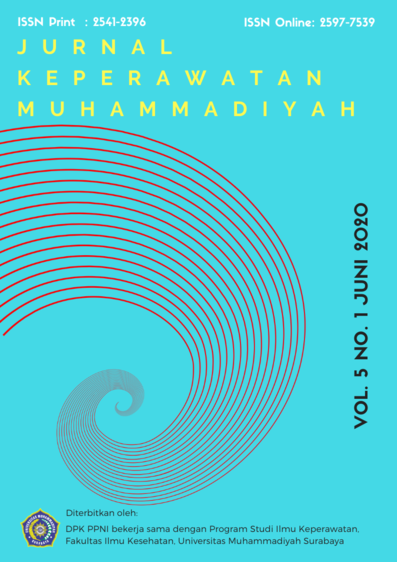KONSUMSI PANGAN PADA BALITA STUNTING : A CASE STUDY
DOI:
https://doi.org/10.30651/jkm.v5i1.17782Keywords:
Food Consumtion, Stunted, ToddlresAbstract
Stunting is a condition where the height or body length of children under five does not match their age as evidenced by the length or height exceeding the standard deviation of the child's growth. The purpose of this study was to identify the food consumption of stunting toddlers in the Ngagelrejo Community Health Center Work Area. The research design used is descriptive with a case study approach. This data collection uses the 3x24 hour food recall method by recording everything consumed by toddlers during the last 24 hours. The prevalence of stunting in Indonesia is 24.4%. In East Java the incidence of stunting in 2021 is 23.5%, while the incidence of stunting inSurabaya according to the BKKBN (2022) is 20%. The results showed that two out of five toddlers only consumed rice and side dishes or rice and vegetable soup only. Two out of five toddlers rarely eat fruit. Four out of five toddlers have a frequency of consuming snacks more than the main food. Three out of five toddlers experience alack of energy. The energy coverage for the three toddlers was 1577 kcal for the first respondent, 1010.2 kcal for the second respondent and 643.2 kcal for the fifth respondent. Five toddlers are deficient in Vitamin D and Calcium. The coverage of vitamin D in the first respondent was 5.6 mcg, in the second respondent 3 mcg, in the third respondent 0.8 mcg, in the fourth respondent 4.1 mcg, and in the fifth respondent 0 mcg. The coverage of calcium consumption in the first respondent was 539.7 mg, the second respondent was 236.8 mg, the third respondent was 496.1 mg, the fourth respondent was 325.3 mg, and the fifth respondent was 267.5 mg.
References
Basuki, S. R., Sastramihardja, H. S., & Setiowulan, W. (2021). Hubungan Pola Konsumsi Kudapan dengan Stunting pada Anak Kelas 1-2 SDN 036 Ujungberung Kota Bandung. Sari Pediatri, 23(2), 121-8.
Dinas Kominfo Provinsi Jawa Timur. (2022). Di Masa Pandemi Angka
Stunting di Jatim Mengalami Penurunan.
Hendrayati dan Asbar, Ramlan. (2018). Analisis Faktor Determinan Kejadian Stunting pada Balita Usia 12 sampai 60 Bulan. Jurusan Gizi, Politeknik Kementrian Kesehatan Makasar
Kemenkes RI. (2021). Penurunan Prevalensi Stunting Tahun 2021 Sebagai Modal Menuju Generasi Emas Indonesia 2045: Jakarta
Langi, G. K., Harikedua, V. T., Purba,
R. B., & Pelanginang, J. I. (2019). Asupan zat gizi dan tingkat pendapatan keluarga terhadap kejadian stunting pada anak usia 3-5 tahun. Jurnal Gizido, 11(2), 51-56.
Loya, R. R. P., & Nuryanto, N. (2017). Pola asuh pemberian makan pada bayi stunting usia 6-12 bulan di Kabupaten Sumba Tengah, Nusa Tenggara Timur. Journal of Nutrition College, 6(1), 84-95. https://doi.org/10.14710/jnc.v6i1
.16897
Masturoh I., Anggita N.T. (2018). Metodologi Penelitian Kesehatan. Jakarta: Badan Pengembangan dan Pemberdayaan Sumber Daya Kesehatan
Nurmalasari, Y., Sjariani, T., & Sanjaya, P. I. (2019). Hubungan tingkat kecukupan protein dengan kejadian stunting pada balita usia 6-59 bulan di desa mataram ilir kec. Seputih surabaya kabupaten lampung tengah tahun 2019. Jurnal of Medical and Health Science, 6(2), 92-97.
Pries, A. M., Rehman, A. M., Filteau, S., Sharma, N., Upadhyay, A., & Ferguson, E. L. (2019). Unhealthy Snack Food and Beverage Consumption Is Associated with Lower Dietary Adequacy and Length-for-Age z- Scores among 12-23-Month- Olds in Kathmandu Valley, Nepal. The Journal of nutrition, 149(10), 1843–1851.
https://doi.org/10.1093/jn/nxz14 0
Putri, A. S. R., & Mahmudiono, T. (2020). Efektivitas pemberian makanan tambahan (PMT) Pemulihan pada status gizi balita di Wilayah Kerja Puskesmas Simomulyo, Surabaya. Amerta Nutrition, 4(1), 58-64.
Pusdatin Kemenkes RI. (2018). Data dan Informasi Kesehatan: Situasi Balita Pendek (Stunting) di Indonesia. Jakarta: Kementrian Kesehatan Republik Indonesia
RAMADHANI, A. T. (2019).
Hubungan Asupan Protein, Kalsium dan Seng Terhadap Kejadian Stunting pada Balita Umur 3-5 Tahun di Kecamatan Gubeng, Kelurahan Mojo, Surabaya (Penelitian Analitik Observasional) (Doctoral
dissertation, Universitas Airlangga).
Srg, I. R., Nasution, S. B., Sofia, E., & Pane, H. F. (2021). Analisis Kadar Kalsium dan Magnesium Terhadap Kejadian Stunting Balita di Puskesmas Titipapan Medan Deli. Jurnal Riset Kesehatan Poltekkes Depkes Bandung, 13(2), 517-524.
Tim Nasional Percepatan Penanggulangan Kemiskinan. (2017). 100 Kabupaten/Kota Prioritas Untuk Intervensi Anak Kerdil (Stunting). Jakarta
World Health Organisation. (2018). WHO Global Nutrtion Targets 2025: Stunting Policy Brief
World Health Organisation. (2018). Stunted Growth and Development.
Wulandari, R. C., & Muniroh, L. (2020). Hubungan Tingkat Kecukupan Gizi, Tingkat Pengetahuan Ibu, dan Tinggi Badan Orangtua dengan Stunting pada Balita di Wilayah Kerja Puskesmas Tambak Wedi Surabaya. Amerta Nutrition, 4(2), 95–102.
https://doi.org/10.20473/amnt.v4 i2.2020.95-102
Zebua, A., Hadi, S., & Bakce, D. (2020). ANALISIS FAKTOR- FAKTOR YANG
MEMPENGARUHI POLA KONSUMSI PANGAN RUMAHTANGGA PETANI SAYURAN DI KABUPATEN
KAMPAR. Jurnal Agribisnis, 21(2), 163–172.
Downloads
Published
Issue
Section
License
- Penulis tetap memegang hak atas karyanya dan memberikan hak publikasi pertama kepada jurnal ini yang secara simultan karya tersebut dilisensikan di bawah:Â Creative Commons Attribution-ShareAlike 4.0 International (CC BY-SA 4.0)













